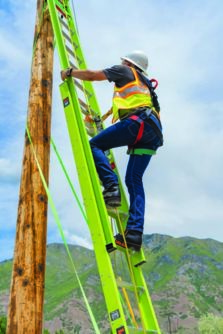Tying off on ladders
Do workers need to be tied off while on a ladder?

Responding is Dave Francis, national safety director, Little Giant Ladder Systems, Springville, UT.
The quick answer is no, but let me explain why. The OSHA standard for construction (29 CFR 1926.501) requires workers to use fall protection with an unprotected edge that is 6 feet above a lower level. The standard for general industry, walking-working surfaces (1910 Subpart D) requires fall protection at 4 feet. This protection can be provided by a guardrail, safety net or personal fall protection system. Neither standard requires fall protection for workers on portable ladders.
Portable ladders (extension, A-frame or stepladder) are freestanding. If a worker is tied off to a freestanding ladder and falls, the ladder would fall with the worker and potentially cause more injury. Even if the ladder is properly tied off and staked at the base, the ladder is not an approved anchor point. If an approved anchor point is above a worker using a ladder, it would be considered a best practice – but not required – to use fall protection while climbing.
Although not required by OSHA standards, some companies’ safety policies require fall protection while working from a portable ladder. If that is the case, OSHA would require workers to follow that rule, even if the requirements are greater than OSHA’s.
Remember: Even the best personal fall protection harness and lanyard are only as strong as the anchor point. If a certified anchor point is available, make sure it does not require extra exposure or danger to attach to it. In other words, a worker should not climb 20 feet to tie off when he or she will be working at only 4 feet.
New portable ladders on the market provide an engineered guardrail at the top of the ladder. Safety cages are fixed or adjustable fiberglass platform ladders with a built-in 42-inch guardrail. Instead of trying to find anchor points everywhere, just use a safety cage with a guardrail to comply with tie-off rules.
Editor's note: This article represents the independent views of the author and should not be construed as a National Safety Council endorsement.
Post a comment to this article
Safety+Health welcomes comments that promote respectful dialogue. Please stay on topic. Comments that contain personal attacks, profanity or abusive language – or those aggressively promoting products or services – will be removed. We reserve the right to determine which comments violate our comment policy. (Anonymous comments are welcome; merely skip the “name” field in the comment box. An email address is required but will not be included with your comment.)

